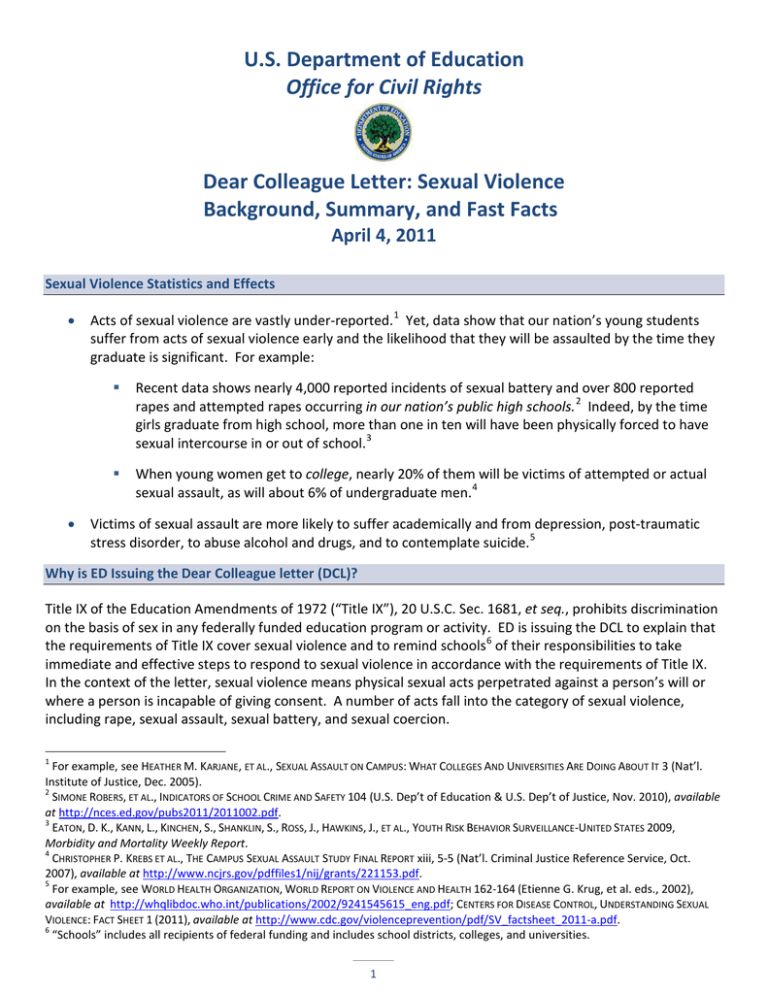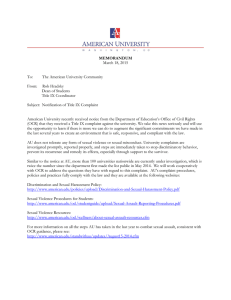
U.S. Department of Education
Office for Civil Rights
Dear Colleague Letter: Sexual Violence
Background, Summary, and Fast Facts
April 4, 2011
Sexual Violence Statistics and Effects
•
•
Acts of sexual violence are vastly under-reported. 1 Yet, data show that our nation’s young students
suffer from acts of sexual violence early and the likelihood that they will be assaulted by the time they
graduate is significant. For example:
Recent data shows nearly 4,000 reported incidents of sexual battery and over 800 reported
rapes and attempted rapes occurring in our nation’s public high schools. 2 Indeed, by the time
girls graduate from high school, more than one in ten will have been physically forced to have
sexual intercourse in or out of school.3
When young women get to college, nearly 20% of them will be victims of attempted or actual
sexual assault, as will about 6% of undergraduate men.4
Victims of sexual assault are more likely to suffer academically and from depression, post-traumatic
stress disorder, to abuse alcohol and drugs, and to contemplate suicide. 5
Why is ED Issuing the Dear Colleague letter (DCL)?
Title IX of the Education Amendments of 1972 (“Title IX”), 20 U.S.C. Sec. 1681, et seq., prohibits discrimination
on the basis of sex in any federally funded education program or activity. ED is issuing the DCL to explain that
the requirements of Title IX cover sexual violence and to remind schools6 of their responsibilities to take
immediate and effective steps to respond to sexual violence in accordance with the requirements of Title IX.
In the context of the letter, sexual violence means physical sexual acts perpetrated against a person’s will or
where a person is incapable of giving consent. A number of acts fall into the category of sexual violence,
including rape, sexual assault, sexual battery, and sexual coercion.
1
For example, see HEATHER M. KARJANE, ET AL., SEXUAL ASSAULT ON CAMPUS: WHAT COLLEGES AND UNIVERSITIES ARE DOING ABOUT IT 3 (Nat’l.
Institute of Justice, Dec. 2005).
2
SIMONE ROBERS, ET AL., INDICATORS OF SCHOOL CRIME AND SAFETY 104 (U.S. Dep’t of Education & U.S. Dep’t of Justice, Nov. 2010), available
at http://nces.ed.gov/pubs2011/2011002.pdf.
3
EATON, D. K., KANN, L., KINCHEN, S., SHANKLIN, S., ROSS, J., HAWKINS, J., ET AL., YOUTH RISK BEHAVIOR SURVEILLANCE-UNITED STATES 2009,
Morbidity and Mortality Weekly Report.
4
CHRISTOPHER P. KREBS ET AL., THE CAMPUS SEXUAL ASSAULT STUDY FINAL REPORT xiii, 5-5 (Nat’l. Criminal Justice Reference Service, Oct.
2007), available at http://www.ncjrs.gov/pdffiles1/nij/grants/221153.pdf.
5
For example, see WORLD HEALTH ORGANIZATION, WORLD REPORT ON VIOLENCE AND HEALTH 162-164 (Etienne G. Krug, et al. eds., 2002),
available at http://whqlibdoc.who.int/publications/2002/9241545615_eng.pdf; CENTERS FOR DISEASE CONTROL, UNDERSTANDING SEXUAL
VIOLENCE: FACT SHEET 1 (2011), available at http://www.cdc.gov/violenceprevention/pdf/SV_factsheet_2011-a.pdf.
6
“Schools” includes all recipients of federal funding and includes school districts, colleges, and universities.
1
What does the DCL do?
•
•
•
•
•
Provides guidance on the unique concerns that arise in sexual violence cases, such as the role of
criminal investigations and a school’s independent responsibility to investigate and address sexual
violence.
Provides guidance and examples about key Title IX requirements and how they relate to sexual
violence, such as the requirements to publish a policy against sex discrimination, designate a Title IX
coordinator, and adopt and publish grievance procedures.
Discusses proactive efforts schools can take to prevent sexual violence.
Discusses the interplay between Title IX, FERPA, and the Clery Act 7 as it relates to a complainant’s right
to know the outcome of his or her complaint, including relevant sanctions facing the perpetrator.
Provides examples of remedies and enforcement strategies that schools and the Office for Civil Rights
(OCR) may use to respond to sexual violence.
What are a school’s obligations under Title IX regarding sexual violence?
•
•
•
•
•
•
Once a school knows or reasonably should know of possible sexual violence, it must take immediate
and appropriate action to investigate or otherwise determine what occurred.
If sexual violence has occurred, a school must take prompt and effective steps to end the sexual
violence, prevent its recurrence, and address its effects, whether or not the sexual violence is the
subject of a criminal investigation.
A school must take steps to protect the complainant as necessary, including interim steps taken prior
to the final outcome of the investigation.
A school must provide a grievance procedure for students to file complaints of sex discrimination,
including complaints of sexual violence. These procedures must include an equal opportunity for both
parties to present witnesses and other evidence and the same appeal rights.
A school’s grievance procedures must use the preponderance of the evidence standard to resolve
complaints of sex discrimination.
A school must notify both parties of the outcome of the complaint.
How can I get help from OCR?
OCR offers technical assistance to help schools achieve voluntary compliance with the civil rights laws it
enforces and works with schools to develop approaches to preventing and addressing discrimination. A school
should contact the OCR enforcement office serving its jurisdiction for technical assistance. For contact
information, please visit ED’s website at http://wdcrobcolp01.ed.gov/CFAPPS/OCR/contactus.cfm.
A complaint of discrimination can be filed by anyone who believes that a school that receives Federal financial
assistance has discriminated against someone on the basis of race, color, national origin, sex, disability, or age.
The person or organization filing the complaint need not be a victim of the alleged discrimination, but may
complain on behalf of another person or group. For information on how to file a complaint with OCR, visit
http://www2.ed.gov/about/offices/list/ ocr/complaintintro.html or contact OCR’s Customer Service Team at
1-800-421-3481.
7
The Family Educational Rights and Privacy Act is at 20 U.S.C. Sec. 1232g, and the Jeanne Clery Disclosure of Campus Security and
Campus Crime Statistics Act is at 20 U.S.C. Sec. 1092(f).
2




